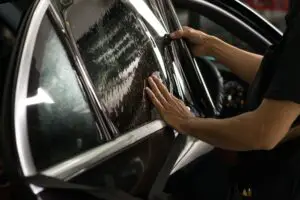Window tint laws were introduced in Indiana back in 2003, and there are a lot of them to go over as they regulate the tints of the windows and impose various rules on the manufacturers of these tint films as well.
Indiana window tint laws limit most cars and vehicles to 30% VLT at the minimum.
While this does not apply to some vehicle windows, as I will explain later in the article, it should be a base for most people in the state.
Windshields do not allow non-reflective tints, and the tints applied must be used above the manufacturer’s AS 1 line.
This is but a brief glimpse into the tinting laws that Indiana has imposed on its citizens.
To get the full taste of how many rules and regulations people must follow, read the rest of the article.
Table of Contents
- 1 How Much Tint Darkness Is Legal In Indiana?
- 2 Window Tint Reflection And Tint Colors
- 3 Medical Exemption Of Window Tint Laws In Indiana
- 4 Get A Certified Sticker From The Company
- 5 Other Window Tint Law Rules And Regulations In Indiana
- 6 Cost Of Car Window Tint In Indiana
- 7 Frequently Asked Questions
- 8 Conclusion
How Much Tint Darkness Is Legal In Indiana?

As mentioned above, for the most part, 30% tint darkness is allowed in the state of Indiana for most cars and vehicle windows.
Some windows can break this restriction, but if you want to play it safe, staying at 30% should be a good idea.
Tint Darkness Limit For SUVs And Vans
The rules are quite relaxed and easy to understand when it comes to sports utility vehicles and vans. The windshield should not have any form of reflective tints on it.
Any tint you apply on the windshield should be well above the manufacturers AS 1 line.
Moving on to the front seat side windows, they have restricted having at least 30% light pass through them.
This restriction was only limited to the front seat side windows as the back seat side windows did not have any such restrictions and instead allowed tints of any darkness; however, these types of tints must be applied several inches from the top of the window.
While this is kept unspecified, I recommend you keep it at 5 inches.
This same rule is applied to the rear window, which can utilize tints of any darkness so long as they do not go near the top of the window.
Tint Darkness Limit For Sedans
In contrast with the rules and regulations for sports utility vehicles and vans, sedans’ restrictions are much simpler and easier to understand.
1. Front Windshield
Windshields are allowed tints so long as they are nonreflective. The tints must also be above the manufacturer’s AS 1 line. This rule is kept the same for SUVs and vans.
2. Front Seat Side Windows
Getting into this with the front seat side windows, the main restriction imposed is that the window tints must allow 30% of let to pass through.
This is established as a trend for the rest of the vehicles.
3. Rear Window
Moving back to the other windows, the rear window shows the same restriction as the front seat side windows, requiring more than 30% of light to pass through the windows.
4. Back Seat Side Windows
This is continued with the back seat side windows, which have the same rule; at least 30% VLT is required.
Window Tint Reflection And Tint Colors
- The state of Indiana has a few basic rules on reflective window tints.
- You cannot have tints on the front seat side windows that are more than 25% reflective.
- This is the same for the back seat side windows, which must be less than 25% reflective.
- The state of Indiana has not said anything about metallic or mirrored tints.
- There are no such rules against the use of colored tints in the state of Indiana.
- You should be able to use any colored tints you want so long as they have the proper VLT levels.
Medical Exemption Of Window Tint Laws In Indiana

While most people tend to rather follow the rules or break them, some are physically incapable of following these window tint laws without suffering a lot of pain.
Usually, these people have a condition that prevents them from standing in direct sunlight for too long.
These people can avoid the rules set by the state of Indiana by applying for a medical exemption letter. This can be obtained from your optometrist or a licensed physician.
Both of them must provide their written certification and must indicate that the person applying for the exemption is suffering from a condition or illness and require special window tints or that the tints being used are a medical necessity.
This is great news for people who need the medical exemption; however, it must be renewed every year.
Get A Certified Sticker From The Company
While this is not necessary if certain states, it is a requirement here; the people in the state of Indiana must buy window tints from manufacturers that sell certified window tint film.
This rule is related to the manufacturers and does not apply to the people purchasing the window tints unless they know they are buying illegal tints.
These manufacturers must have a certificate that states that the tints they produce are under the standards set by the state of Indiana.
The people who apply the tints are not required to have any stickers or certificates to show that the window tint is legal.
Other Window Tint Law Rules And Regulations In Indiana
Here are a few other window tint laws in the state of Indiana that the people must know about:
- A medical exemption is possible, but your exemption letter must be renewed every year.
- There are no restrictions placed on the side mirrors of the vehicle.
- Tint owners are not required to have documents or stickers to identify whether their tints are legal or not.
- Colored tints are completely legal in the state of Indiana.
Cost Of Car Window Tint In Indiana
If you are in the market for some window tints but are not sure how much they can cost you, do not fear, as I will now talk about the tint costs in Indiana.
Standard tinting can cost you anything over $200 and cover the whole vehicle.
This, however, is only for people who own a standard truck. If you get an extended truck, the cost goes up by $30, and for your average sedan, it will cost you $250.
Depending on the size of your SUV, it can cost you anything from $250 to $330, and all of these are for standard tints. Premium tints can easily go over $400 and reach up to $800.
Frequently Asked Questions
Q1. Is 15% Tint Legal In Indiana?
For the most part, 15% of tints are not legal on sedans; however, if you are an SUV owner, you can apply them on the back seats and rear seat windows.
Q2. Are 5% Tints Legal In Indiana?
Similar to the 15% tints, 5% tints are illegal on all windows of Sedans and hence cannot be used. However, the rear seats and the back seat side windows of SUVs and vans are fair game.
Q3. Is Limo Tint Legal In Indiana?
Limo tints are usually very dark and do not allow a lot of light to pass through them, meaning they cannot be used on Sedans or SUVs’ front seat side windows.
You can, however, use them on the rear and back seat side windows.
Q4. Can I Get Pulled Over For Tint In Indiana?
If an officer believes that you are using tints that do not follow the rules set by the state, you can be pulled over and are liable for a ticket.
Q5. How Much Is A Tint Ticket In Indiana?
Tint tickets are a class C infraction and bring a hefty fine of $500, which is only for the first time. Subsequent fines will only get bigger as you get caught.
Conclusion
Indiana tint laws are similar to many different states and impose mostly the same rules to a varying degree.
They allow for medical exemptions, which many people can benefit from, while only not requiring the people to have certificates or stickers to show that their tints are legal.
In some aspects, the laws of the state of Indiana are very vague and do not provide enough information, leaving it up to the people to understand what they require and how.
Apart from this, all of the laws in Indiana about window tinting are pretty self-explanatory, and you should be able to follow them with the help of this article.

I am Tahir Azam, and I have been writing amazing articles for TaxiHack for as long as I can remember. I know everything that is to know when it comes to automobiles and is always on top of industry news and developments. While I am not an expert by any means, I pride myself on knowing the ins and outs of many different problems and, of course, their solutions. The articles on our website are some of the best and well-researched content that you will find, and I spend countless hours making sure this remains to be true. This is why I ask you to take your time out and read some of my articles, especially if you find a topic that resonates with you or is something you are looking into. This way, you will find the perfect mix of information and tips on your desired topic. Learn more about Tahir.



